In the minds of gracefully aging motorcycle enthusiasts, perceptions can count for fact. Trading in your fearsome supersport for a plastic-clad travel barge can be taken as the first shaky step off the staircase of youth. And once the tumble commences, so it says here, the fall is inevitable and hard. Open the garage door to see a motorcycle as big as a car. You could break your hip.
Not if BMW has its way. Reentering the category after a nine-year absence is the long running RS, now based on the R 1200 R platform and carrying the prolifically used wasserboxer engine. Understanding the RS’s positioning is easy: Not an S 1000 RR, not an R 1200 RT. Sporty but not hard-core committed. Touring capable but considerably more lithe and manageable. Depending on your point of view—and, maybe, your age bracket—that might be the worst of both worlds, or the best.
BMW takes the R-RS’s history back to the seminal R90S, connecting its best sport bike of the day with an added degree of wind protection to make it a traveler. Not so much in 2016, because the R1200R baseline is far more traditional, in the BMW way, than any of the S1000 models. Instead, think of the new R/RS series as a fusion of naked and R-GS elements—that’s a steel-tube frame, shaft final drive, available Dynamic ESA (Electronic Suspension Adjustment) dampers, and a whole suite of electronics.
Plopping a handsome and aerodynamically effective half-fairing onto the R 1200 R chassis adds 12 pounds, for a claimed curb weight of 520. (Notable that the much more powerful S 1000 XR comes in at 502 pounds wet, right?) In virtually every other way, the R and RS are identical. It’s the same engine and state of tune as on the R and the GS—a claimed 125 hp at 7,750 rpm and 92 pound-feet of torque at 6,500 rpm. BMW has since the launch of the R 1200 GS Adventure normalized water boxer engines with the slightly heavier crankshaft to make the engine a bit more tractable at the expense of energetic revviness. Don’t take that the wrong way: This engine is twice as charismatic than the previous boxer.
There are changes for the R and RS compared to the GS, specifically the final-drive ratio. Intended to have a strong touring element to its makeup, the RS gets a 2.82:1 ratio compared to the 2.91 of the GS. Otherwise, it’s familiar territory with the liquid-cooled, four-valve-per-cylinder twin, new slipper wet clutch (with an effort-assist feature), and ride-by-wire fueling. Like the GS, the RS has ride modes that dictate throttle response and the intervention levels of the standard traction control and ABS.
Here’s where we have to interject something about option packages, so sit tight; it’ll make sense later. The base R 1200 RS starts at $14,950, a price that includes basic traction control and ABS, two ride modes (Rain and Road), a spiffy multifunction display, and manually adjusted suspension. If you see one of these on the road, take a picture; the “stripper” RS is likely to be a rare breed.
Instead, you’ll find more of them with the Standard package ($16,025), which adds cruise control, heated grips, chrome exhaust, and saddlebag mounts. (These are nicely integrated so you won’t mind hitting your weekend sporting roads without the optional hard bags you’re almost certainly going to buy.) Most common will be the R 1200 RS in the Premium package ($17,770), which adds keyless ignition, Gear Shift Assist Pro (up and down quick shift with auto-blipping on the downshift), Dynamic ESA, GPS preparation, centerstand, luggage rack, and an enhanced on-board computer.
Okay, that enough? Not quite. If you go all-in, you’ll want to add Ride Modes Pro (a $350 option). Why? Here we are back to the engine. In the lesser forms, the RS is delivered without a lean-angle sensor, so the traction control is the basic ASC, which compares wheel speeds and cuts throttle and/or spark accordingly. With Ride Modes Pro, you get DTC (Dynamic Traction Control), which is a finer, more sophisticated version that allows more latitude for fun. Also with Ride Modes Pro, you get an additional two ride modes, called Dynamic and User.
Here’s how it stacks up. The Rain ride mode makes the throttle response softer than normal, and resets the thresholds for TC and ABS to a lower level. Road gives more direct throttle response and higher thresholds. Dynamic sharpens the throttle response ever further, and builds yet higher thresholds into the DTC. User simply allows you to mix-and-match elements of the other rides modes, so you can have medium throttle response with higher thresholds, if you like. Also, bless ‘em, BMW allows you to switch TC and ABS off completely, even on the fly.
We’d love to tell you how the RS works with Ride Modes Pro, but the test bikes at the Muskoka Lakes launch—about two hours north of Toronto—were not equipped with the lean-angle sensor, and so were limited to two ride modes. Oh, the tragedy! They were, however, all fitted with Dynamic ESA, which is common to the R model. This iteration uses a 46mm Sachs fork with the ESA electronic damping cartridge in one fork leg, but no preload adjustment up front; remember that the S1000R and RR both have mechanical preload with their similar DDS electronic damping systems. At the rear, a Marzocchi shock gets dynamic damping and electrically adjusted spring preload to one of three settings.
Last bit of housekeeping, then. The R and RS are essentially similar machines, with the same basic bodywork (save for the half fairing on the RS, of course), but the RS got minor tweaks for its more touring-oriented role. Specifically, its wheelbase is half an inch longer, it carries 0.4 inches less trail (at the same 27.7-degree steering-head angle), and its standard 32.3-inch seat height is 1.2 inches higher than on the R. Cast handlebar risers place the grips slightly lower and further forward than on the R, but the position is very moderate, resulting in a slight forward lean of your torso. Thankfully, the standard seat affords good legroom; the stock saddle on the R cramps even shorter riders. An even taller saddle is available as an option.
In the R1200RS, the personality you get is exactly the one you expect. In being neither too quick nor too ungainly, the RS stakes out the middle ground with superb, totally neutral handling, suspension calibrated right in the middle of the grid, and engine character that emphasizes midrange grunt and superlative manners over eye-watering thrust. Push on one of the heated grips and the RS carves into corners with total predictability. If you really want to hustle the transitions, plan on using a bit of body position or weight transfer. This is not a flick-flick kind of bike. But once it’s carving, the RS is a gem—completely neutral and balanced. It’ll continue carving arcs until you get tired of holding the throttle open, even as the D-ESA pumps furiously over rough pavement. On that: In the Dynamic mode, the system is nicely firm for smooth roads, with minimal fork plunge when you use the strong (but not too touchy) radial-mount Brembos. But damping is a tad stout for really frost-heaved pavement, which seems to be a local craft in Ontario. Relax it to Road mode and it’s much better, a pleasing combination of plushness and control. Even better, the key chassis components—braking effect, suspension action, steering response—all feel very high quality. In no way does the RS feel cost-constrained.
Carrying over the water boxer engine makes the RS a capable distance runner with minimum fuss and good mileage; we saw 43 mpg on the trip computer despite the bikes being almost literally zero-miles machines. The taller gearing works wonders here, giving the RS a truly relaxed cadence on the highway yet preserving some verve on the faster sweepers, where the bike wants to live. Less goat path, more grand, arcing secondary roads, thanks.
And while the RS carries much of BMW’s signature technology—and the vast majority of it works seamlessly—there are still a couple of hiccups. In the upper gears, the Gear Shift Assist Pro works marvelously, but it’s touchy in the lower gears; the auto-blip and ignition-cut schemes perform far better when you’re riding with aggression. Moreover, the new dot-matrix instrument panel is a study in form over function, with an analog speedometer whose numbers are too small and too close together (consider the demographic!) and a bar-graph tach that’s hard to decipher at a glance. We’d rather have those swapped, thanks.
That’s all picking on the small kids in class, though. Overall, the RS is a calm, reassured, comfortable motorcycle, capable of exciting cornering performance before the footpegs begin tinkling off the pavement, and promising excellent long-range comfort. We didn’t spend extended periods at the helm, but the firm saddle, very good aerodynamics (thanks to a two-position-adjustable screen), and low commotion level all hint at a bike you won’t mind spending the day on. So before you trade in your supersport for a 600-plus-pound sport-touring rig, it may be worth looking at the RS. If this is the halfway point between youthful exuberance and the onset of seniorism, maybe a midlife crisis isn’t so bad.














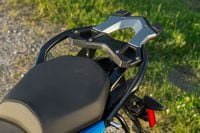



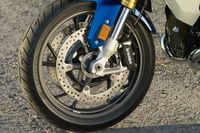




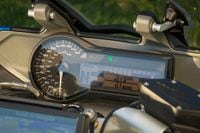

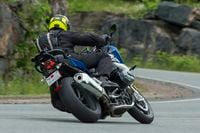
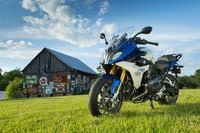





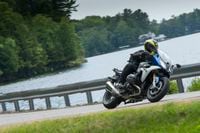



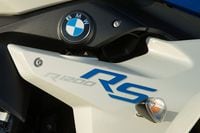





/cloudfront-us-east-1.images.arcpublishing.com/octane/ITNLTIU5QZARHO733XP4EBTNVE.jpg)
/cloudfront-us-east-1.images.arcpublishing.com/octane/VZZXJQ6U3FESFPZCBVXKFSUG4A.jpg)
/cloudfront-us-east-1.images.arcpublishing.com/octane/QCZEPHQAMRHZPLHTDJBIJVWL3M.jpg)
/cloudfront-us-east-1.images.arcpublishing.com/octane/HXOUJXQWA5HBHGRO3EMJIGFMVI.jpg)

/cloudfront-us-east-1.images.arcpublishing.com/octane/3TIWWRV4JBBOLDVGRYECVVTA7Y.jpg)
/cloudfront-us-east-1.images.arcpublishing.com/octane/KIX5O23D5NAIBGFXBN3327DKZU.jpg)
/cloudfront-us-east-1.images.arcpublishing.com/octane/7GJYDUIPXRGMTMQKN6ONYOLBOU.jpg)
/cloudfront-us-east-1.images.arcpublishing.com/octane/MUQLOVLL2ZDGFH25ILABNBXKTI.jpg)
/cloudfront-us-east-1.images.arcpublishing.com/octane/TNOU5DNE2BC57MFPMGN2EIDXAM.jpg)
/cloudfront-us-east-1.images.arcpublishing.com/octane/GTCXACQGJ5HAPDTGWUQKDEH44E.jpg)
/cloudfront-us-east-1.images.arcpublishing.com/octane/S35YGSEMEZB4BLTDJTSZPF4GLA.jpg)
/cloudfront-us-east-1.images.arcpublishing.com/octane/5UOT6HPX2JFMRJAX6EH45AR4MQ.jpg)
/cloudfront-us-east-1.images.arcpublishing.com/octane/OKWOJWAKP5EP3OACCRRWPCIX2Q.jpg)
/cloudfront-us-east-1.images.arcpublishing.com/octane/2WF3SCE3NFBQXLDNJM7KMXA45E.jpg)
/cloudfront-us-east-1.images.arcpublishing.com/octane/G4MG6OUCJNBSHIS2MVVOTPX65E.jpg)
/cloudfront-us-east-1.images.arcpublishing.com/octane/IIGGWFOTOJGB7DB6DGBXCCMTDY.jpg)
/cloudfront-us-east-1.images.arcpublishing.com/octane/QSTCM6AVEZA5JJBUXNIQ3DSOF4.jpg)
/cloudfront-us-east-1.images.arcpublishing.com/octane/U4I7G625B5DMLF2DVIJDFZVV6M.jpg)
/cloudfront-us-east-1.images.arcpublishing.com/octane/B6XD6LS6IVCQPIU6HXDJSM3FHY.jpg)
/cloudfront-us-east-1.images.arcpublishing.com/octane/ICL63FEDDRDTTMINYICCEYGMDA.jpg)
/cloudfront-us-east-1.images.arcpublishing.com/octane/FCGZHQXRBZFLBAPC5SDIQLVF4I.jpg)
/cloudfront-us-east-1.images.arcpublishing.com/octane/WNOB6LDOIFFHJKPSVIWDYUGOPM.jpg)
